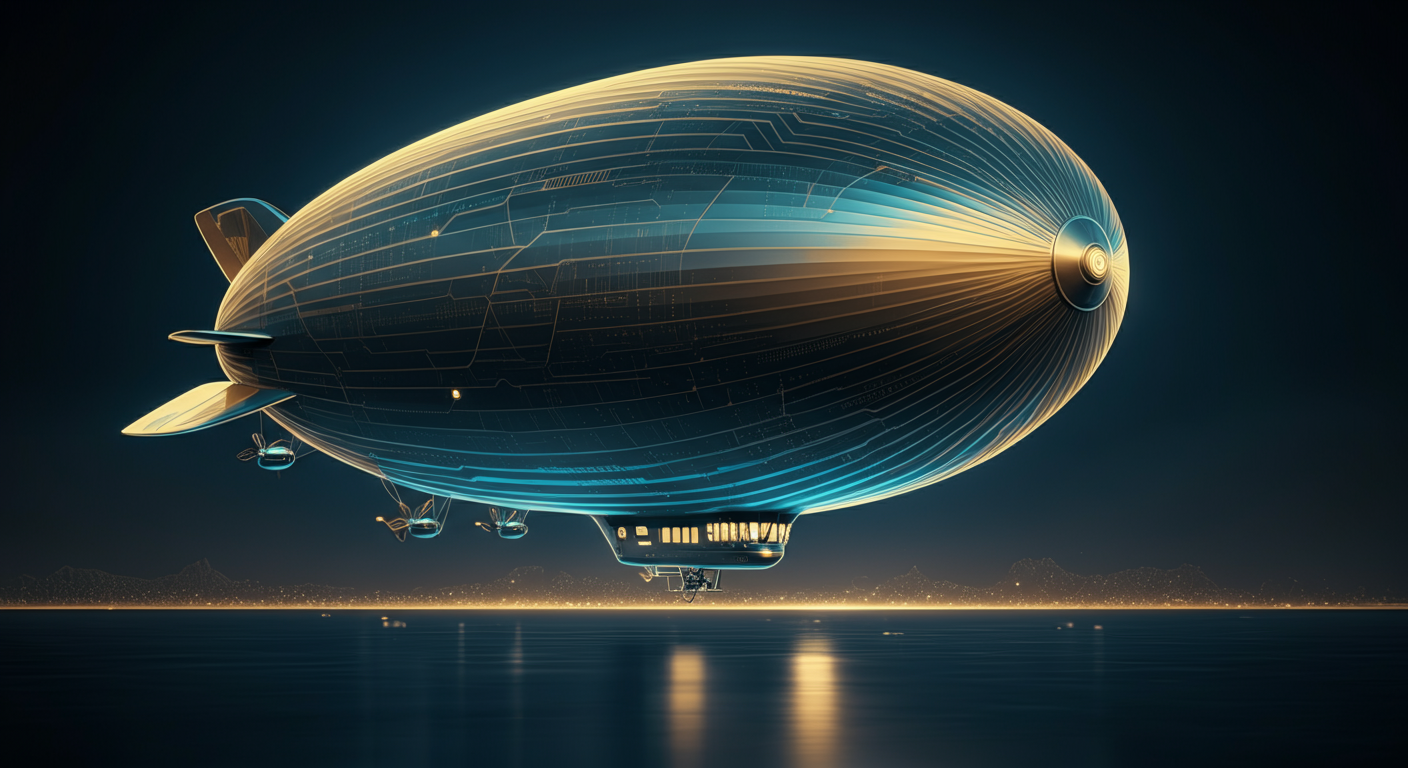Blimp Technology: A Comprehensive Guide to Airship Innovation, Applications, and the Future of Flight

The romance of flight often conjures images of sleek jets and roaring rockets, but there's a quiet, enduring fascination with a different kind of aircraft: the blimp.
A History Etched in the Skies
Blimps, those gentle giants of the air, once ruled the skies, offering a luxurious and novel mode of transportation. Their initial popularity stemmed from a combination of technological novelty and a unique passenger experience.Blimps represent more than just outdated technology; they embody a persistent human desire to conquer the skies in unconventional ways.
The Allure Endures
Despite historical setbacks and the rise of faster, more efficient aircraft, blimps continue to capture the imagination. They offer:- A unique perspective: A slow, steady aerial view unavailable on modern aircraft
- Practical potential: Modern airships are finding niches in surveillance, advertising, and even cargo transport. Companies are developing and testing modern airships with advanced materials and propulsion systems.
- Technological Advancements: Modern airships incorporate cutting-edge technologies like hybrid propulsion, advanced materials, and sophisticated navigation systems. This has the potential to increase fuel efficiency and operational range.
Debunking Misconceptions
It’s easy to dismiss blimps as relics of a bygone era, but this overlooks their evolving capabilities. Modern airships are far from the cumbersome, unreliable craft of the past; advancements in materials science and engineering have yielded safer, more efficient, and more versatile designs.The blimp's enduring appeal lies not just in nostalgia but in its potential for a unique and evolving role in the future of flight.
It's easy to mix up "blimp" and "airship," but understanding their structural differences clarifies everything.
Blimp Basics: The Non-Rigid Approach
A blimp, technically a non-rigid airship, maintains its shape solely through internal gas pressure. Think of a massive, inflated balloon.- Key feature: No internal frame.
- How it works: Simply filled with lighter-than-air gas like helium.
- Example: Goodyear Blimps – iconic and instantly recognizable.
Airship Classification: Beyond Blimps
Airships come in three primary designs:| Type | Structure | Advantages | Disadvantages | Example |
|---|---|---|---|---|
| Blimp | Non-rigid | Simpler construction, lower cost | Limited size, susceptible to weather | Goodyear Blimp |
| Semi-rigid | Partial Frame | Better shape control than blimps | More complex than blimps | |
| Rigid | Full Frame | Large size, high payload capacity | Most complex, highest cost | Zeppelin |
Advantages and Disadvantages
"Choosing the right airship design depends heavily on the intended application."
- Blimps: Ideal for advertising and surveillance due to lower operational costs.
- Rigid Airships (like Zeppelins): Suited for long-distance travel and heavy cargo transport, despite higher complexity and cost. Consider the sheer volume a Zeppelin can hold.
Visualizing the Difference
Imagine a sausage casing (blimp) versus a skyscraper with a balloon inside (rigid airship). Semi-rigid designs fall somewhere in between, employing a partial frame to stiffen the envelope. To learn more, consult the AI Glossary for definitions.Understanding the spectrum of airship designs – from simple blimps to complex Zeppelins – opens new perspectives on the future of aviation and the potential of lighter-than-air technology. Now that we've nailed the basics, let’s explore the practical applications.
Here's the science behind how blimps gracefully take to the skies.
The Magic of Buoyancy: Helium vs. Hydrogen
Blimps achieve flight using buoyancy, where an object rises when it displaces a weight of air greater than its own. The lifting force depends on the difference between the weight of the air and the weight of the gas inside the airship.Think of it like a hot air balloon, but instead of heating the air, blimps use lighter-than-air gases.
- Helium is a non-flammable, stable, and safe gas commonly used for buoyancy today.
- Hydrogen, although providing slightly more lift, is highly flammable and was historically linked to disastrous accidents, like the Hindenburg.
Altitude Control: Mastering the Vertical Dance
Blimps don't just float; they control their altitude. They do so with:- Ballonnets: Internal air compartments inflate or deflate to adjust the airship's volume and maintain pressure as the outside temperature and pressure change.
- Gas Management: Releasing gas causes the blimp to descend, while pumping air into the ballonnets allows it to ascend.
Propulsion Systems: Moving Through the Air
Getting from point A to point B requires more than just floating. Blimps use various propulsion systems:- Engines & Propellers: Traditional combustion engines drive propellers, pushing the airship forward.
- Electric Motors: Modern blimps increasingly use electric motors, often paired with propellers, offering a quieter, more efficient, and environmentally friendly alternative.
Maneuverability: Steering the Gentle Giants
Controlling a blimp is an art.- Rudders: Control horizontal movement, allowing the blimp to turn left or right.
- Elevators: Manage vertical movement, directing the blimp up or down.
- Vectored Thrust: Some blimps use engines that can pivot, directing thrust upwards or downwards for enhanced control and maneuverability.
Modern blimps are not just for advertisements; their unique capabilities are being harnessed in various innovative fields.
Surveillance and Security
Blimps are equipped with advanced sensor technology, making them effective aerial surveillance platforms. Imagine a silent, persistent eye in the sky, providing real-time monitoring for large events or critical infrastructure. This can greatly improve security and response times compared to traditional methods.Scientific Research
- Atmospheric monitoring: Blimps can carry instruments to measure air quality, track weather patterns, and study climate change.
- Environmental studies: Researchers can use airships to observe wildlife, map ecosystems, and assess environmental damage with minimal impact on the environment. Consider blimps as "eco-drones" that support sustainable science.
Cargo Transport
Blimps present an energy-efficient solution for cargo delivery, especially to remote or difficult-to-access areas. Airship cargo transport offers a slower but greener alternative to traditional airplanes or trucks.Imagine a future where remote communities receive essential supplies via airship, bypassing the need for expensive and environmentally damaging infrastructure.
Telecommunications
Blimps can serve as aerial platforms for telecommunications, providing broadcasting capabilities and internet access to underserved areas. These floating cell towers can enhance connectivity and bridge the digital divide, offering a flexible solution for expanding network coverage.Tourism and Luxury Travel
Blimp tourism is emerging as a unique and luxurious way to experience travel. Offering panoramic views and a smooth, quiet ride, they provide an unforgettable aerial journey. Think of it as a "floating balcony," offering a relaxed and eco-friendly way to see the world.In summary, modern blimp applications extend far beyond advertising, offering innovative solutions in surveillance, scientific research, cargo transport, telecommunications, and tourism. Transitioning to AI-driven technologies, Best AI Tools enhance everything from airship navigation to data processing, leading to even greater efficiency and expanded capabilities.
Here's how technological advancements are fueling the blimp renaissance.
Materials Science: Lighter and Stronger
Advancements in airship materials science are pivotal. Forget the fragile fabrics of yesteryear. We're talking about:- Lightweight synthetic fabrics that drastically reduce the overall weight. This increased strength to weight ratio allowes for greater payloads and fuel efficiency.
- Durable envelope materials resistant to punctures, UV radiation, and extreme weather. It's all about longevity and safety.
Propulsion Systems: Efficiency Takes Flight
Say goodbye to noisy, polluting engines. The future of blimp propulsion is green:- Hybrid-electric blimps, combining electric motors with fuel-efficient generators, are becoming the norm. This dramatically reduces emissions.
- Solar power integration, where solar panels integrated into the airship's envelope provide supplementary energy. Think persistent surveillance or long-duration atmospheric research.
Autonomous Flight and AI: The Brains of the Operation
AI-powered blimps are no longer a dream. Airships are learning to fly themselves:- Autonomous flight control systems, utilizing advanced sensors and algorithms, handle navigation, stability, and maneuvering. Imagine precision delivery in urban environments.
- AI-driven decision-making for weather avoidance, route optimization, and emergency response. It's about enhanced safety and operational efficiency.
Navigation and Communication: Staying Connected
Modern blimps are equipped with cutting-edge technology:- Advanced blimp navigation systems, incorporating GPS, inertial measurement units (IMUs), and computer vision, to ensure precise positioning and guidance.
- Satellite communication systems for real-time data transmission, weather updates, and air traffic control integration. Staying connected is key.
It's time to ditch the fossil fuels and take to the skies with a surprising champion of sustainability: the blimp.
Carbon Footprint Comparison
Blimps offer a significantly lower carbon footprint compared to traditional airplanes.- Airplanes guzzle fuel for lift and propulsion.
- Blimps, relying on buoyancy, primarily need energy for propulsion. Think of it like comparing a gas-guzzling SUV to a fuel-efficient electric car; the difference is substantial. The exact blimp carbon footprint will depend on size, speed, and fuel source.
Biofuel and Hydrogen Potential
The future of sustainable air transport could be fueled by innovation.- Airship biofuel: Integrating biofuels offers a drop-in replacement for conventional fuels, minimizing environmental harm from sourcing to combustion.
- Hydrogen power: Shifting to hydrogen as a fuel source unlocks near-zero carbon emissions, marking a monumental stride towards ecological aviation.
Environmental Benefits in Surveillance
Imagine replacing noisy, polluting helicopters and fleets of ground vehicles with quiet, electric blimps.- Reduced ground traffic means less congestion and emissions.
- Blimps offer a stable, high-altitude platform for monitoring without the constant fuel burn of helicopters.
Helium Sourcing and Sustainability

The elephant in the (air)ship: Helium is a finite resource.
- Addressing helium sourcing issues through responsible sourcing and innovative solutions like capturing helium from natural gas production are crucial.
- Research into alternative lifting gases, though challenging, could further enhance blimp sustainability.
The future of blimps is not just about nostalgia; it's about revolutionary potential.
Revolutionizing Transportation and Logistics
Imagine blimps easing urban congestion. These airships could offer a greener alternative for transporting goods and people, bypassing crowded roads and railways.- Urban air mobility networks
- Point-to-point delivery of goods
Stratospheric Airships
Blimps could soon reach near-space altitudes.- For near-space exploration: a cost-effective alternative to satellites.
- Communication relays: offering stable, long-duration platforms for broadcasting and data transmission.
Emerging Companies and Projects
Several companies are actively pushing the boundaries of airship technology, designing blimps for diverse applications.- Hybrid Air Vehicles: Developing the Airlander 10, a hybrid airship designed for heavy cargo transport.
- LTA Research: Focused on developing lighter-than-air vehicles for humanitarian aid and disaster relief, Google co-founder Sergey Brin's initiative.
Disaster Relief and Humanitarian Aid

Blimps could play a crucial role in disaster response scenarios.
- Delivering supplies to isolated areas
- Providing aerial surveillance and communication hubs
- Pokee AI could be useful in coordinating these efforts by analyzing data from the blimp to effectively allocate resources.
In summary, blimps are poised for a renaissance, and like many tools in the AI Tool Universe, the possibilities are vast. Perhaps blimps will be supported with tools for Data Analytics to predict weather patterns, or perhaps even assist with Design AI Tools to better optimize the aerodynamics of their builds. As technology advances, expect airships to take on increasingly important roles in our skies.
Addressing the Challenges: Safety, Regulations, and Public Perception
While blimp technology is soaring, navigating its challenges is crucial for widespread adoption. Let's unpack the hurdles and potential solutions.
Safety First: Blimp Safety Records and Concerns
Despite historical incidents, modern blimps boast a strong safety record.
- Redundancy: Multiple engines and independent control systems enhance safety.
- Slow Speeds: Lower speeds reduce impact forces in case of an incident.
- Non-flammable Gases: Modern airships commonly use helium, a non-flammable gas, mitigating fire risks.
Regulatory Landscape: Navigating Airspace and Operation
Airship operations are governed by aviation authorities like the FAA, with regulations covering design, manufacturing, and operation.
- Current Framework: Existing regulations may need updates to accommodate new airship technologies and operational models.
- Future Changes: Anticipate regulations adapting to autonomous airships and novel uses. For example, a deeper understanding of AI legislation(https://best-ai-tools.org/learn/glossary/ai-legislation) is useful for companies operating in this space, given the increasing integration of AI in airship operations.
Public Perception: Building Trust and Acceptance
Overcoming skepticism is key to unlocking blimp technology's potential.
- Education: Highlighting safety advancements and environmental benefits is essential.
- Demonstrations: Showcasing practical applications can build public confidence.
- Addressing Concerns: Openly addressing safety concerns and operational limitations fosters trust. You can learn more about key concepts by visiting our AI Glossary(https://best-ai-tools.org/ai-news/ai-glossary-key-artificial-intelligence-terms-explained-simply).
Economical Considerations: Comparing Costs and Benefits
While initial investment costs can be high, blimps offer long-term economic advantages.
- Fuel Efficiency: Blimps consume significantly less fuel than traditional aircraft.
- Versatile Applications: From cargo transport to surveillance, diverse uses can offset operational costs.
- Infrastructure Costs: Minimal infrastructure requirements compared to airports can result in substantial savings.
Keywords
blimp, airship, lighter-than-air, airship technology, blimp applications, modern airships, airship innovation, blimp history, airship design, airship future, helium blimp, autonomous airship, airship cargo, stratospheric airship, hybrid airship
Hashtags
#AirshipTech #BlimpRevolution #FutureOfFlight #SustainableAviation #AirshipInnovation
Recommended AI tools

Your AI assistant for conversation, research, and productivity—now with apps and advanced voice features.

Bring your ideas to life: create realistic videos from text, images, or video with AI-powered Sora.

Your everyday Google AI assistant for creativity, research, and productivity

Accurate answers, powered by AI.

Open-weight, efficient AI models for advanced reasoning and research.

Generate on-brand AI images from text, sketches, or photos—fast, realistic, and ready for commercial use.
About the Author

Written by
Dr. William Bobos
Dr. William Bobos (known as 'Dr. Bob') is a long-time AI expert focused on practical evaluations of AI tools and frameworks. He frequently tests new releases, reads academic papers, and tracks industry news to translate breakthroughs into real-world use. At Best AI Tools, he curates clear, actionable insights for builders, researchers, and decision-makers.
More from Dr.

